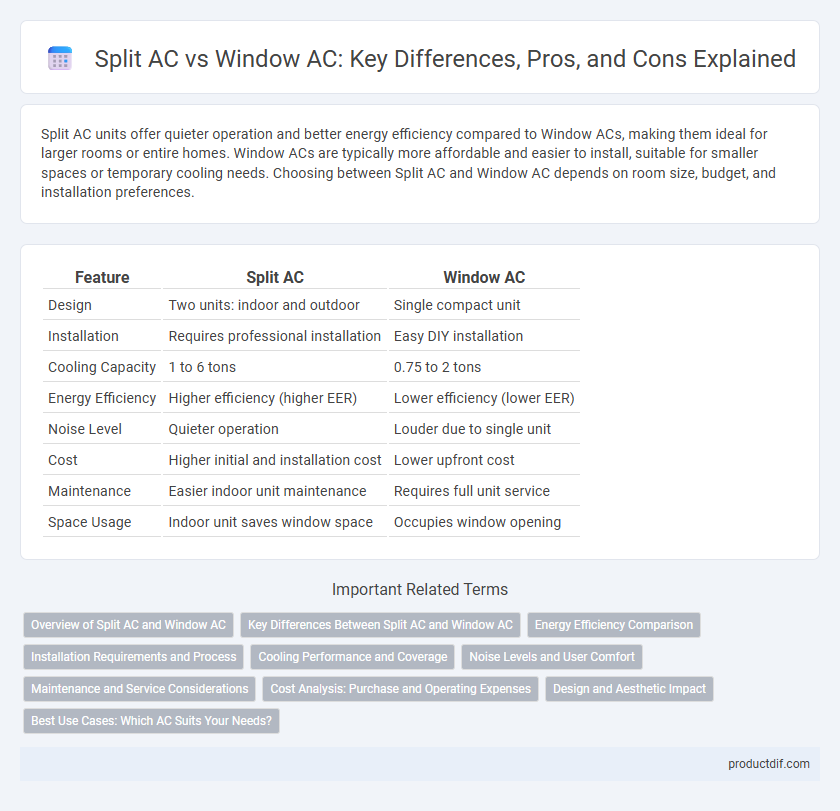Split AC units offer quieter operation and better energy efficiency compared to Window ACs, making them ideal for larger rooms or entire homes. Window ACs are typically more affordable and easier to install, suitable for smaller spaces or temporary cooling needs. Choosing between Split AC and Window AC depends on room size, budget, and installation preferences.
Table of Comparison
| Feature | Split AC | Window AC |
|---|---|---|
| Design | Two units: indoor and outdoor | Single compact unit |
| Installation | Requires professional installation | Easy DIY installation |
| Cooling Capacity | 1 to 6 tons | 0.75 to 2 tons |
| Energy Efficiency | Higher efficiency (higher EER) | Lower efficiency (lower EER) |
| Noise Level | Quieter operation | Louder due to single unit |
| Cost | Higher initial and installation cost | Lower upfront cost |
| Maintenance | Easier indoor unit maintenance | Requires full unit service |
| Space Usage | Indoor unit saves window space | Occupies window opening |
Overview of Split AC and Window AC
Split AC units consist of two separate components--the indoor evaporator and the outdoor compressor--offering quieter operation and easier installation flexibility compared to Window ACs. Window ACs are compact, self-contained units that fit within a window frame, providing cost-effective cooling but typically generate more noise and are less visually appealing. Both systems use refrigerant cycles to cool air, but Split ACs generally deliver higher energy efficiency and better temperature control.
Key Differences Between Split AC and Window AC
Split AC units feature separate indoor and outdoor components, offering quieter operation and aesthetic appeal, while window ACs place all components in a single unit installed in a window frame. Split ACs provide better cooling efficiency and are ideal for larger rooms, whereas window ACs are suitable for smaller spaces due to their compact design and ease of installation. Energy consumption varies, with split ACs generally delivering higher energy efficiency compared to window ACs, impacting long-term electricity costs.
Energy Efficiency Comparison
Split AC systems generally offer higher energy efficiency compared to window AC units due to advanced inverter technology and better airflow distribution. Window ACs typically consume more power because of their single-unit design and less sophisticated compressors. Energy Star ratings often favor split AC models, making them more cost-effective for long-term electricity savings.
Installation Requirements and Process
Split AC systems require professional installation involving mounting the indoor unit on a wall and placing the outdoor compressor unit outside, connected by refrigerant pipes and electrical wiring. Window AC units offer a simpler installation process, primarily needing a window or a wall space with an electrical outlet and basic sealing for efficient operation. Split AC installation demands more time and technical expertise, while window ACs can be installed quickly by homeowners with minimal tools.
Cooling Performance and Coverage
Split AC units typically offer superior cooling performance with higher BTU ratings and advanced compressor technology, enabling efficient temperature control across larger spaces compared to window ACs. Window ACs are generally suitable for small rooms due to their limited cooling capacity and coverage area, often struggling to maintain consistent cooling in bigger environments. The enhanced airflow distribution and quieter operation of split ACs contribute to more effective and comfortable cooling in medium to large rooms.
Noise Levels and User Comfort
Split AC units typically operate at lower noise levels, around 19-30 decibels, providing a quieter indoor environment compared to window ACs, which often generate noise levels between 40-60 decibels. The separation of the condenser in split ACs reduces vibration and sound inside the room, enhancing user comfort during sleep or work. Window ACs, due to their compact design and integrated components, may cause more audible disturbances, impacting overall comfort in noise-sensitive settings.
Maintenance and Service Considerations
Split AC units generally require professional maintenance due to their separate indoor and outdoor components, which demand regular inspection for refrigerant levels, coil cleaning, and electrical connections. Window ACs offer easier DIY maintenance since all parts are housed in a single unit, simplifying filter cleaning and basic repairs. Service costs for split ACs tend to be higher compared to window ACs because of their complex installation and specialized parts.
Cost Analysis: Purchase and Operating Expenses
Split AC units typically have higher initial purchase prices compared to Window ACs but offer greater energy efficiency, leading to lower operating expenses over time. Window ACs are more budget-friendly upfront but often consume more electricity, increasing monthly utility bills. Evaluating long-term electricity costs alongside installation fees is crucial for an accurate cost analysis between split and window air conditioners.
Design and Aesthetic Impact
Split AC units feature a sleek, wall-mounted indoor unit that blends seamlessly with modern interiors, providing a minimalistic and unobtrusive appearance. Window ACs are bulkier, installed within a wall or window frame, often disrupting the room's aesthetic and limiting interior design flexibility. The discreet design of split ACs enhances room decor by avoiding extensive framing and visible mechanical parts present in window AC models.
Best Use Cases: Which AC Suits Your Needs?
Split AC units offer efficient cooling for larger rooms and provide quieter operation, making them ideal for living rooms and bedrooms with minimal noise disturbance. Window ACs are cost-effective and easier to install, suitable for smaller spaces like single rooms or offices with limited budgets. Choosing between split and window AC depends on factors such as room size, installation flexibility, noise levels, and budget constraints.
Split AC vs Window AC Infographic

 productdif.com
productdif.com